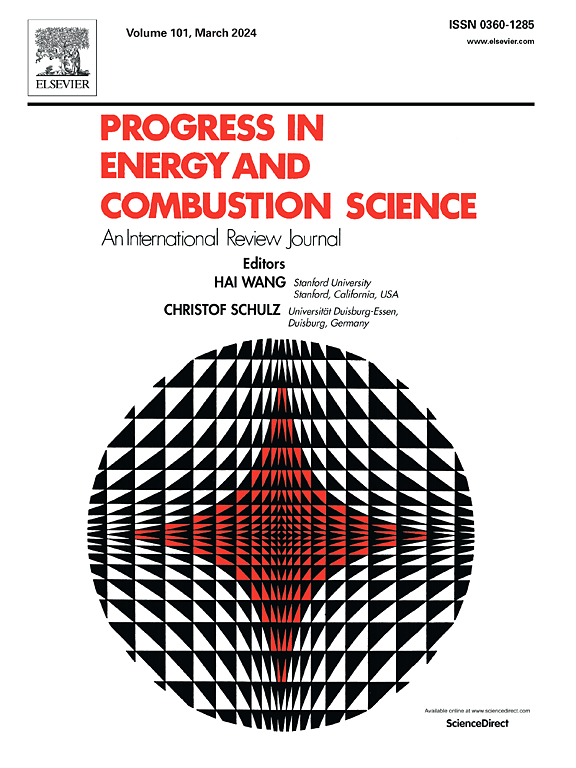Progress in multi-scale modeling of soot particle aggregation in laminar sooting flames
IF 37
1区 工程技术
Q1 ENERGY & FUELS
引用次数: 0
Abstract
The toxicity, climate impact, as well as the physical and chemical properties of ultra-fine soot particles emitted from combustion systems are strongly dependent on their size and morphology. Research attention has been paid in the last three decades to developing more accurate and capable methods to model soot particle coagulation in the presence of inception, surface growth, and oxidation, to predict particle size distribution as well as the detailed aggregate morphology of soot. While soot particle concentrations in hydrocarbon flames are primarily governed by soot kinetics, the morphology of soot particles is controlled by both soot kinetics and particle dynamics. Flame-generated soot particles are fractal aggregates formed by polydisperse and nearly spherical primary particles with a certain degree of overlapping. The properties of fractal aggregates, nanoparticle coagulation, and soot formation chemistry all play important roles in soot formation. This article reviews all these aspects but the focus is on recent progress in macro- and meso-scale modeling of soot particle aggregation in laminar sooting flames to avoid the complexities of turbulence. The reviewed macro-scale methods based on the population balance equation include the commonly used sectional methods and methods of moments. The main features of three recently developed state-of-the-art meso-scale methods, namely the event-driven Discrete Element Method, Monte Carlo Aggregation Code, and detailed stochastic population balance model are reviewed. To highlight the complexities of modeling the particle size distribution and detailed particle morphology without and with surface growth, numerical simulations of three test cases were conducted using the event-driven Discrete Element Method, the Monte Carlo Aggregation Code, and the two macro-scale methods. A detailed analysis of the results was presented to understand how different treatments of particle coagulation and surface growth in the two meso-scale methods affect the predicted particle size and morphology. The remaining challenges in modeling detailed soot particle morphology are outlined.
层流烟尘火焰中烟尘颗粒聚集的多尺度模拟研究进展
燃烧系统排放的超细煤烟颗粒的毒性、气候影响以及物理和化学性质在很大程度上取决于它们的大小和形态。在过去的三十年里,研究人员一直致力于开发更准确、更有能力的方法来模拟煤烟颗粒在初始、表面生长和氧化过程中的混凝,以预测煤烟的粒径分布以及详细的聚集形态。碳氢化合物火焰中烟尘颗粒的浓度主要受烟尘动力学的控制,而烟尘颗粒的形态则同时受烟尘动力学和粒子动力学的控制。火焰产生的烟尘颗粒是由多分散的近球形初级颗粒形成的分形聚集体,并有一定程度的重叠。分形聚集体的性质、纳米颗粒的混凝和烟尘的形成化学都对烟尘的形成起着重要的作用。本文综述了这些方面,但重点介绍了为了避免湍流的复杂性,在层流烟尘火焰中烟尘颗粒聚集的宏观和中尺度模拟方面的最新进展。目前评述的基于人口平衡方程的宏观尺度方法包括常用的截面法和矩量法。综述了最近发展的三种最先进的中尺度方法的主要特点,即事件驱动离散元法、蒙特卡罗聚合码和详细的随机种群平衡模型。为了突出模拟没有和有表面生长的粒径分布和详细颗粒形态的复杂性,使用事件驱动离散元方法、蒙特卡罗聚合码和两种宏观尺度方法对三个测试用例进行了数值模拟。对结果进行了详细的分析,以了解两种中尺度方法中不同的颗粒凝聚和表面生长处理如何影响预测的颗粒大小和形态。在建模详细的烟灰颗粒形态剩下的挑战概述。
本文章由计算机程序翻译,如有差异,请以英文原文为准。
求助全文
约1分钟内获得全文
求助全文
来源期刊

Progress in Energy and Combustion Science
工程技术-工程:化工
CiteScore
59.30
自引率
0.70%
发文量
44
审稿时长
3 months
期刊介绍:
Progress in Energy and Combustion Science (PECS) publishes review articles covering all aspects of energy and combustion science. These articles offer a comprehensive, in-depth overview, evaluation, and discussion of specific topics. Given the importance of climate change and energy conservation, efficient combustion of fossil fuels and the development of sustainable energy systems are emphasized. Environmental protection requires limiting pollutants, including greenhouse gases, emitted from combustion and other energy-intensive systems. Additionally, combustion plays a vital role in process technology and materials science.
PECS features articles authored by internationally recognized experts in combustion, flames, fuel science and technology, and sustainable energy solutions. Each volume includes specially commissioned review articles providing orderly and concise surveys and scientific discussions on various aspects of combustion and energy. While not overly lengthy, these articles allow authors to thoroughly and comprehensively explore their subjects. They serve as valuable resources for researchers seeking knowledge beyond their own fields and for students and engineers in government and industrial research seeking comprehensive reviews and practical solutions.
 求助内容:
求助内容: 应助结果提醒方式:
应助结果提醒方式:


